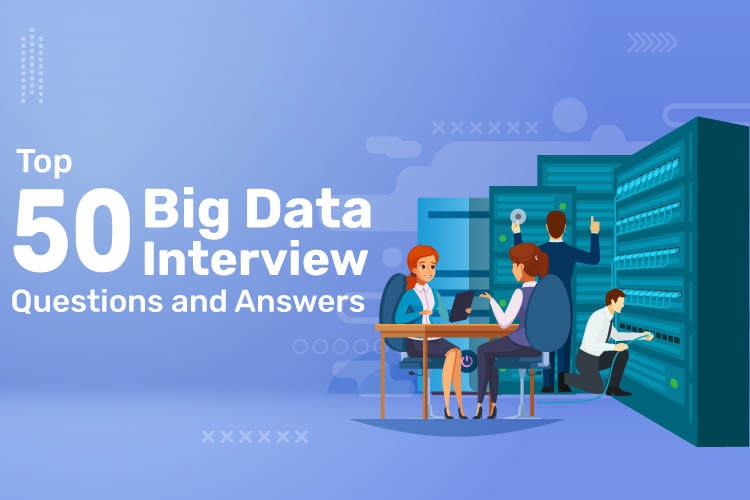- June 11, 2021
- nschool
- 0

Top 50 Big Data Interview Questions and Answers
Organizations are searching for talent at all levels in the area of Big data. With these top 50 Big data interview questions and answers, you can get ahead of the competition for that big data career. Big Data is a game-changer technology. It has changed the way data are previously collected and processed, and it is expected to continue to do so shortly. The massive amounts of data aren’t as overwhelming as they once were.
Big Data has applications in every industry and has aided the growth of the automation and artificial intelligence (AI) industries. This is why every company in the world needs Big Data experts to help them streamline their operations by handling large amounts of structured, unstructured, and semi-structured data. Since Big Data has become a standard, there are a plethora of job opportunities.
This article will go over some of the most popular Big Data interview questions and how to respond to them.
BIG DATA INTERVIEW QUESTIONS FOR FRESHERS
The below basic set of big data questions will strongly equip freshers to face the interview.
1. Tell us about Big Data in your own words.
Big Data is a collection of huge amounts of data that cannot be handled, stored, or analyzed using conventional data processing techniques due to its scale and exponential growth.
2. Explain in detail the 3 different types of big data.
STRUCTURED DATA: It implies that the information can be processed, stored, and retrieved in a predetermined format. Contact numbers, social security numbers, ZIP codes, employee records, and wages, among other things, are examples of highly ordered information that can be quickly accessed and processed.
UNSTRUCTURED DATA: This is data that does not have a particular structure or type. Audio, video, social media posts, digital surveillance data, satellite data, and other forms of unstructured data are the most common types.
SEMI-STRUCTURED DATA: This is an undefined but essential term that applies to both structured and unstructured data formats.
3. What is Hadoop?
Hadoop is an open-source software architecture for storing and processing data on commodity hardware clusters. It has a lot of storage for any kind of data, a lot of computing power, and it can handle practically unlimited concurrent tasks or jobs.
4. Are Hadoop and Big Data interconnected?
Big Data is a resource, and Hadoop is an open-source software application that helps to manage that resource by achieving a set of goals and objectives. To extract actionable insights, Hadoop is used to process, store, and analyze complex unstructured data sets using proprietary algorithms and methods. So, Yes, they are related, but they are not the same.
5. Mention the important tools used in Big Data analytics.
The important tools used in Big Data Analytics are as follows,
- NodeXL
- KNIME
- Tableau
- Solver
- OpenRefine
- Rattle GUI
- Qlikview
- Cloudera
- MapR
- Amazon EMR (Elastic MapReduce)
- Microsoft Azure HDInsight
- IBM InfoSphere Information Server for Data Integration and
- Hortonworks.
- Standalone mode
- Pseudo Distributed mode (Single node cluster)
- Fully distributed mode (Multiple node cluster)
- Oozie
- Ambari
- Pig
- Flume
- Data Ingestion
- Data Storage and
- Data Processing
- To start a new NameNode, use the fsimage, which is a file system metadata replica.
- Configure the DataNodes as well as the clients to recognize the newly launched NameNode.
- The client will be served once the new NameNode has finished loading the last checkpoint FsImage and obtained enough block reports from the DataNodes.
- Management of information.
- Financial services.
- Cybersecurity and protection.
- Managing social media posts.
- Adobe
- Yahoo
- Ebay
- JobTracker is a Hadoop JVM process for submitting and tracking MapReduce jobs.
- In Hadoop, JobTracker conducts the following tasks in order:
- JobTracker receives jobs that are submitted by a client application.
- NameNode is notified by JobTracker to evaluate the data node.
- JobTracker assigns TaskTracker nodes based on the number of slots open.
- It submits the work to the TaskTracker Nodes that have been assigned to it, and JobTracker keeps an eye on the TaskTracker nodes.
- DFA is not fault-tolerant
- The amount of data that can be moved over a network is determined by bandwidth.

